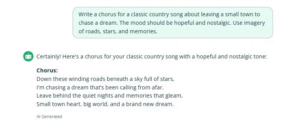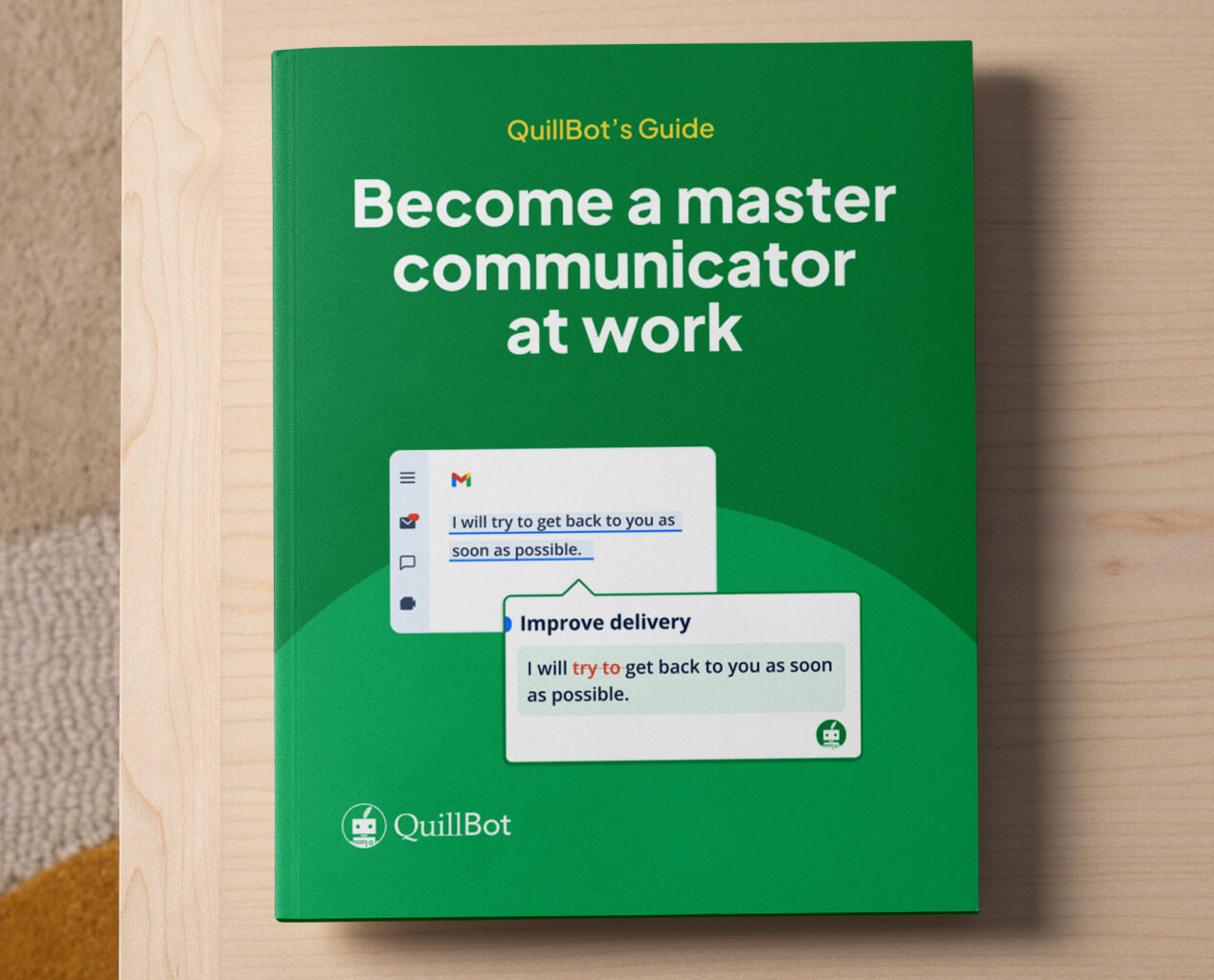How to Use AI to Write Lyrics | Steps & Examples
Writing song lyrics can be a deeply creative but challenging process. Whether you’re stuck on the first verse or searching for the perfect end rhyme, it’s easy to hit a wall. That’s where AI-powered lyric generators come in. These tools help you turn song ideas into fully formed lyrics faster than you can say “do-re-mi.”
There are many AI tools to help you write lyrics, such as QuillBot’s free AI lyric generator.
How to write lyrics
To write song lyrics (with or without the help of generative AI), follow the four steps outlined below.
1. Pick a concept for your song
Start by choosing a concept for your song, which includes the theme, genre, and mood.
- The theme is the message that your song will communicate about a certain topic (e.g., “money can’t buy happiness”).
- The genre is the style of music, such as country, hip-hop, pop, heavy metal, or folk. Consider whether your song will be part of a subgenre, such as outlaw country.
- The mood is the emotion that your song will convey (e.g., melancholy, excitement, joy, or regret).
- Theme: “Leaving your comfort zone is painful but necessary.”
- Genre: Classic country
- Mood: Melancholy and nostalgic
2. Freewrite or brainstorm ideas
After you choose a concept, brainstorm details about the characters, narrator, setting, and imagery that your lyrics might include. Set a timer for about 10 minutes, and write down everything that comes to mind about your song’s topic. Some of the details you might brainstorm include:
- Objects that are symbolic of your theme
- Colors and other sensory details that match the mood
- Words or phrases that you associate with the topic
3. Write a chorus
The chorus is a few lines of lyrics that repeat several times in the song. It’s supposed to be catchy and memorable to entice listeners to sing along. To write a good chorus:
- Use simple language that people can relate to
- Repeat key phrases from the song title or about the theme
- Choose a rhyming pattern (e.g., every other line or every line)
- Use the same general length (e.g, the same number of syllables) for each line
4. Write the verses
The verses of your lyrics tell the story and/or develop your theme. Each verse should be unique and contain new information. If your lyrics will follow a narrative structure, outline which plot points each verse will cover. For example, if the story has six parts, you’ll need six verses to alternate with your chorus.
- Verse 1: A childhood moment in her grandma’s cozy kitchen
- Verse 2: A time during adolescence when Grandma gave her a family heirloom
- Verse 3: An epiphany during college about her grandmother’s mortality
- Verse 4: Saying goodbye to her grandma in hospice
- Verse 5: Sharing the family heirloom with her own children
Using an AI lyric generator
You can use QuillBot’s free AI lyric generator during any steps in the lyric-writing process. Some of the many ways to write lyrics with AI include the following.
- Prompt AI to write a draft of the complete lyrics. In the prompt, specify the theme/topic, mood, and genre. Also share the number of verses you’re striving for and any ideas you have for the chorus. Then, review the AI-written lyrics, and make adjustments to individual word choices to match your own style.
- Prompt the AI lyric generator to write a verse that you’re stuck on. Include the verses you’ve written so far (along with details about your topic and overall plan) in your prompt.
- Ask the AI lyric generator to write or revise your chorus. For example, an AI lyric generator can revise the lines to have a certain length or end rhyme. You can also ask AI to build a chorus based on a line you already wrote (e.g., “Write a chorus that repeats “even the stars can’t keep us apart”).
Below is an example prompt and the output from QuillBot’s free AI lyric generator.
- Expand this song lyric {You move like midnight} into a full chorus in a ‘90s R&B style.
- Write an indie song based on the title “Fading Polaroid.” The theme is growing distant from a childhood best friend, and the setting is Long Island, NY in the 1980s.
- Write a 16-bar rap verse about rising above self-doubt. Use clever wordplay and a confident tone. Avoid profanity.
Frequently asked questions about how to use AI to write lyrics
- Will AI write lyrics in my personal style?
-
An AI lyric generator can mimic your style if you provide examples of lyrics or other types of writing that you’ve already created in your prompt.
An example of a specific prompt with a writing sample is “Write a verse for a song about body positivity that matches the style of {this verse you already wrote}.”
The QuillBot AI lyric generator can help you write song lyrics in any style that you specify, and you can always revise outputs to add even more of your own personal touches.
- Can AI help with rhyming in song lyrics?
-
Yes, AI can help you create an effective rhyme in song lyrics. When you’re writing a prompt for an AI lyric generator, specify which words you want to rhyme, and the tool will show you words or lines that rhyme with your examples.
An example of a prompt to help with rhyming in song lyrics is “Write lyrics for a pop song about an epic house party. Every other line should rhyme with the word DJ.”
You can also prompt an AI lyric generator to write lyrics that rhyme without specifying a specific rhyme to use.
When you need help with writing amazing rhymes for your song lyrics, QuillBot’s lyric generator is completely free and easy to use.
- What is the difference between symbolism and metaphor?
-
Symbolism and metaphor are easy to confuse. However, they are distinct literary devices.
- Symbolism relies on symbols (objects, persons, or situations) to represent abstract ideas or concepts. A strong symbol is usually related to whatever it is meant to symbolize and often recurs throughout a literary work as a major part of the theme. For example, the raven in Edgar Allan Poe’s eponymous poem symbolizes the narrator’s grief.
- A metaphor, on the other hand, compares two seemingly unrelated things, stating that one thing is another. Metaphors are often brief, like the phrase “Time is a thief.” The purpose is to create vivid imagery, exaggerate a trait, or express a complex idea.
In short, while both symbolism and metaphor involve using one thing to represent another, symbolism relies on recurring symbols to convey deeper meanings, whereas metaphors make a direct comparison to highlight a specific idea.
- What are the different types of rhyme?
-
Rhyme comes in several forms:
End rhyme: Rhymes that occur at the end of lines
Internal rhyme: Rhymes within the same line or in the middle of different lines.
Perfect rhyme: Words that match exactly in sound, like “cat” and “hat.”
Imperfect rhyme: Also known as slant rhyme, it occurs when sounds are similar but not identical, like “love” and “move.”
Eye rhyme: Words that look as if they should rhyme but do not when pronounced, such as “love” and “prove.”Each type creates different musical effects in poetry and prose. Ready to take your poetry or writing to the next level? QuillBot’s Grammar Checker can help you fine-tune your work and ensure it flows perfectly
Cite this Quillbot article
We encourage the use of reliable sources in all types of writing. You can copy and paste the citation or click the "Cite this article" button to automatically add it to our free Citation Generator.
QuillBot. (2025, July 14). How to Use AI to Write Lyrics | Steps & Examples. Quillbot. Retrieved August 11, 2025, from http://qbot.seotoolbuy.com/blog/ai-writing-tools/how-to-use-ai-to-write-lyrics/


